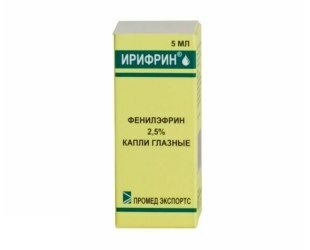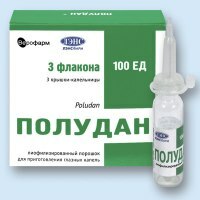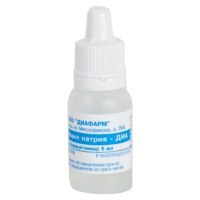
Eye drops Irifrin in ophthalmology is used topically for vasoconstriction, dilating the pupil or reducing intraocular pressure.
Achieved this effect due to the main active substance of the drug - phenylephrine.
The drug has a fairly wide range of applications, because the dilatation of the pupil and the decrease in intraocular pressure are important for the treatment and diagnosis of many eye diseases.
In addition to the above properties, this drug contributes to a normal outflow of the eye fluid and a decrease in edema of the outer shell of the eye. This remedy is also prescribed to reduce the spasm of accommodation during the development of false myopia.
- 1. Instructions for use
- 2. Contraindications
- 3. Terms and storage terms
- 4. Price
- 5. Analogues
- 6. Reviews
- 7. Conclusion
- 8. Video
Instruction for use
Useful properties
The main active substance of the drug is phenylephrine, which is related to sympathomimetics and has alpha-adrenergic activity, which, when used locally, causes pupil dilatation.
There is also an improvement in the outflow of intraocular fluid and a moderate narrowing of the mucosal vessels. In the eye tissue, phenylephrine penetrates quite easily and quickly, pupil dilatation is observed for 10-60 minutes after instillation.
Form and Composition
Dosage Form Irifrin - drops. They are a clear solution of a colorless or yellowish hue. Are issued in special 5 ml plastic bottles with a dispenser, which, in turn, are packed in cardboard boxes.
Drops are of different percentage ratios of 2.5% and 10%.The active ingredient is phenylephrine hydrochloride.
In 1 ml of a 2.5% solution contains 25 mg of the active ingredient, and in 1 ml of a 10% solution of 100 mg.
Additional components in the drug: benzalkonium chloride, edetate disodium, hypromellose, sodium metabisulphite, citric acid, sodium citrate dihydrate, distilled water.
Indications for use
The drug is prescribed in the following cases:
- before ophthalmic operations( including laser), which require the state of mydriasis;
- with conjunctival hyperemia, to determine the type of injection;
- if necessary, expand the pupil to diagnose the eye;
- in iridocyclitis( inflammatory disease of the ciliary body and iris).
Interaction with other drugs
Simultaneous application with atropine leads to an increase in the effect of both agents. As a consequence, there is a risk of developing tachycardia.
Co-use with beta blockers provokes a risk of high blood pressure.
When Irifrin is used simultaneously or for 21 days after completion of MAO inhibitors, there is a risk of an uncontrolled rise in pressure.
With simultaneous use with propranolol, methyldopa, reserpine, tricyclic antidepressants, m-holinoblokatorami and guanetidine, the vasopressor effect of adrenomimetic agents may be potentiated.
The use of a 10% solution of Irifrin simultaneously with the systemic use of beta-blockers can provoke the emergence of acute arterial hypertension.
With inhalation anesthesia, the drug is capable of potentiating a depressant effect on the cardiovascular system. Sharing of irifrin with sympathomimetics can strengthen the cardiovascular effect of phenylephrine.
How to use the drug?
The use and dosage of the drug for each disease are different.
Ophthalmoscopy .With ophthalmoscopy, a 2.5% solution is used once. In order to achieve the expansion of the pupil, or mydriasis inject 1 drop. The maximum dilatation of the pupil is achieved after 15 to 30 minutes and this state persists for 1 to 3 hours. If there is a need to maintain medriasis for a longer time, it is possible to re-instill drops in 60 minutes.
Drops of 10% of the composition can be used for insufficient medrasia in children over 12 years and adults, in patients with rigid iris.
Spasm of accommodation , or false myopia. To remove the spasm, 2.5% drops are administered to children over 6 years of age and adults. Bury 1 drop in each conjunctival sac at night each day. The course of application is 28 days, or 4 weeks.
In case of persistent spasm, children older than 12 years and adults are allowed to use 10% solution. Drip 1 drop into each eye at night each day. The course of treatment is twice as little - 14 days, or 2 weeks.
Iridocyclitis .For this type of inflammation, 2.5% ophthalmic solution or 10% is used. Irifrin prevents the development and rupture of the already existing rear synechia and reduces the release of fluid into the anterior chamber of the eye. In each eye, drop one drop about 2 to 3 times a day.
Glaucomycyclic crisis, or Posner-Schlossman's syndrome .Irifrin due to the active component in the composition reduces intraocular pressure, a particularly pronounced effect has drops having a 10% composition. Apply 2 - 3 times a day.
Preparation for surgical interventions .Use 10% drops for half an hour or an hour before the operation in order for the pupil to expand. Buried once. After opening the shell of the eyeball, instillation of the remedy is no longer acceptable. Also, these drops are not used for irrigation, wetting of tampons during surgery and subconjunctival administration.
Diagnostics. Drops are used to diagnose various diseases once in the form of a 2.5% solution. Are used for:
1. Provocation test in patients with a narrow profile of the angle of the anterior marque, as well as with suspected closure angle glaucoma. The difference between the value of the intraocular pressure before the Irifrin was dripped and after the dilatation of the pupil should be from 3 to 5 mm Hg. With such indicators, the test is considered positive.
2. Differential diagnosis of the type of eyeball injection. If, after instillation after five minutes, the vessels of the eyeball narrowed, the injection is defined as superficial. If the redness of the eyes is preserved, it is important to examine the patient for the presence of such a disease as iridocyclitis or scleritis, since redness may indicate the expansion of more deep vessels.
Contraindications
Irifrin is not recommended for:
- hemoglobin metabolism disorders;
- closed-angle and narrow-angle glaucoma;
- serious cardiovascular disease;
- hyperthyroidism;
- hypersensitivity to the components of the agent.
In addition, these drops should not be used by elderly patients with organic changes in the operation of the vessels of the brain and heart. A 10% solution of the drug should not be used by children under the age of 12 years and children with underweight.
Given that the action of Irifrin on the body during pregnancy and breastfeeding has not been studied well enough, the use of the drug in these cases is possible only if the expected benefit from its use by the mother exceeds the possible risk to the fetus or the baby.
Side effects of

Irifrin has a number of side effects that develop very rarely, but you should know about it.
When using eye drops, reactions such as local irritation, itching, lacrimation, deterioration of visual acuity, burning sensation in the eyes may appear.
Due to the use of drops by elderly patients, they can have reflex narrowing of the pupils every other day.
In some cases, the drug may provoke an exacerbation of heart and vascular disease, a violation of the heart rhythm, an increase in blood pressure.
In rare cases, the use of Irifrin leads to serious cardiovascular disorders, such as vascular collapse, myocardial infarction and intracranial hemorrhage.
Overdose of
In case of local use and observance of the rules specified in the instructions, an overdose of the drug is not observed.

Please note - instructions for eye drops Half-dandy. Reviews and analogues of the drug.
In the article the price for Opatanol. Overview in CIS pharmacies.
Reviews of eye drops Kromogeksal!http: //moezrenie.com/lechenie/ kapli-dlya-glaz / sredstvo-kromogeksal.html
Special instructions
Avoid contact of eyedrops Irifrin with contact lenses - before instillation of eyes, it is necessary to remove lenses from them. You can wear them no less than half an hour after the instillation of the drug.
Irifrin should be used with extreme caution in patients with diabetes mellitus, since there is a risk of increased pressure caused by a violation of autonomic regulation.
Also with caution, the drug should be given to elderly patients due to the increased risk of reactive miosis.
If the recommended dose is exceeded when using 2.5% irifrin solution, patients with diseases or traumas of the eye or its appendages, with reduced tear production or in the postoperative period, may increase the absorption of phenylephrine, which can cause the development of systemic side effects.
Conditions and shelf life
Shelf life is 24 months. After opening, the bottle can be used only for 1 month. Store away from sunlight at a temperature that does not exceed 25 ° C.Drops should not be frozen. Keep away from children. It is released only by prescription.
Price
In Russian pharmacies the average cost of eye drops Irifrin is 400 rubles .The average price of the drug in Ukrainian pharmacies is 130 hryvnia .
Analogues
Phenylephrine, Cyclomed, Mezaton, Visofrin, Atropine, Phenylephrine hydrochloride, Midratsil.
Reviews
Reviews of potential consumers about the drops are different. Among the positive, many note - the effect of the drug, helped in the treatment of diseases, eyesight is improving.
Among the negative reviews complaints of severe burning, both in children and adults. Many people who used these drops caused arrhythmia, tachycardia, dizziness, atrial fibrillation of the heart. Children instead of Irifrin all advise Irifrin BC, which causes less severe burning.
Examples of

No. 1 .I wear glasses for many years. Vision began to deteriorate a long time and rapidly. Even more worried began to worry about the eyes after childbirth, because they often negatively affect the eyesight. After visiting the doctor, he was awed with horror for his verdict. After a series of inspections, I was ready for disappointing forecasts. The result: now the vision is -6.5, a year ago it was -3.75.
The doctor prescribed me a course of treatment with Irifrin drops: 14 days to drip them before bed.
These drops are not the cheapest, and they are enough for just two weeks. Some appoint a course to a month - of course, it turns out a little expensive, but effective.
After two weeks, I went to a re-examination to see a doctor. Vision improved to -4.75.As it turned out, the eye vessels widened due to a strong strain, and Irifrin helped them to return to normal.
By the way, the doctor said that when the drops "cut" the eyes, it's good - so the drug begins to act. I noticed that in the first three days as a result of getting the medicine on their eyes they can not be opened at all. And after a week, the rub was gone.
For prevention, the doctor advised me to drip Irifrin twice a year for two weeks. It should be noted that vision has stabilized.

Note - Instruction for eye drops Sulfacyl Sodium. Reviews and analogues of the drug.
In the news( here) all the analogs of Floxal.
Reviews of Oftan Katachrom!http: //moezrenie.com/lechenie/ kapli-dlya-glaz / oftan-katakhrom.html
# 2 .I suffered for a long time from myopia, which appeared because of the heavy eye strain and mild form of cervical osteochondrosis, which is present in almost every specialist who works a lot with documents or a computer. In addition to deterioration in visual acuity, the muscles around the eyes and even on the forehead were strongly tightened. As a result, a deep crease appeared between the eyebrows. Prescribed vitamins for the eyes did not give the desired result.
After many years in the optics salon, an ophthalmologist recommended this remedy for relieving muscle spasm. It does not sound very plausible, but in the end, the muscle tension is completely gone, the fold on my forehead was almost smoothed out and the harrowing state of harrowing that was tormenting me also disappeared.
Of course, Irifrin is a medical product, so it should be used for its intended purpose. The doctor recommended me to poke it for 5 days, and not more often than one course in six months. Although at this stage, visual impairment will not pass, but after all, appearance and well-being are also not cheap.
Conclusion
- The main component in the composition is phenylephrine, which causes the dilatation of the pupils, improves the outflow of the intraocular fluid, moderately narrows the vessels of the mucosa.
- The effect of the drug is expected within 10 - 30 minutes after instillation and lasts up to three hours.
- It is used in the treatment of iridocyclitis, false myopia, glaucomycyclic crisis, as well as for the diagnosis of diseases, in ophthalmoscopy.
- Has incompatibility in simultaneous use with many medications, for example, with Atropine, Beta-blockers, etc.
- Among the adverse reactions to the drug the strongest and most likely are pressure increase, arrhythmia, tachycardia, etc. Has contraindications.
- Those who wear lenses before using drops should remove them, and after instillation it is necessary to wait about 30 minutes and then only to put on.
- Reviews about the drops are ambiguous, many observed the occurrence of side effects and severe burning eyes.
Video
We bring to your attention an interesting video:
